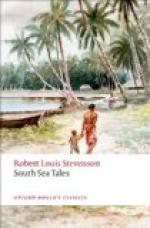But to be able to speak to people is not all. And in the first stage of my relations with natives I was helped by two things. To begin with, I was the show-man of the Casco. She, her fine lines, tall spars, and snowy decks, the crimson fittings of the saloon, and the white, the gilt, and the repeating mirrors of the tiny cabin, brought us a hundred visitors. The men fathomed out her dimensions with their arms, as their fathers fathomed out the ships of Cook; the women declared the cabins more lovely than a church; bouncing Junos were never weary of sitting in the chairs and contemplating in the glass their own bland images; and I have seen one lady strip up her dress, and, with cries of wonder and delight, rub herself bare-breeched upon the velvet cushions. Biscuit, jam, and syrup was the entertainment; and, as in European parlours, the photograph album went the round. This sober gallery, their everyday costumes and physiognomies, had become transformed, in three weeks’ sailing, into things wonderful and rich and foreign; alien faces, barbaric dresses, they were now beheld and fingered, in the swerving cabin, with innocent excitement and surprise. Her Majesty was often recognised, and I have seen French subjects kiss her photograph; Captain Speedy—in an Abyssinian war-dress, supposed to be the uniform of the British army—met with much acceptance; and the effigies of Mr. Andrew Lang were admired in the Marquesas. There is the place for him to go when he shall be weary of Middlesex and Homer.
It was perhaps yet more important that I had enjoyed in my youth some knowledge of our Scots folk of the Highlands and the Islands. Not much beyond a century has passed since these were in the same convulsive and transitionary state as the Marquesans of to-day. In both cases an alien authority enforced, the clans disarmed, the chiefs deposed, new customs introduced, and chiefly that fashion of regarding money as the means and object of existence. The commercial age, in each, succeeding at a bound to an age of war abroad and patriarchal communism at home. In one the cherished practice of tattooing, in the other a cherished costume, proscribed. In each a main luxury cut off: beef, driven under cloud of night from Lowland pastures, denied to the meat-loving Highlander; long-pig, pirated from the next village, to the man-eating Kanaka. The grumbling, the secret ferment, the fears and resentments, the alarms and sudden councils of Marquesan chiefs, reminded me continually of the days of Lovat and Struan. Hospitality, tact, natural fine manners, and a touchy punctilio, are common to both races: common to both tongues the trick of dropping medial consonants. Here is a table of two widespread Polynesian words:-
House. Love.
Tahitian fare AROHA
New Zealand whare
Samoan FALE TALOFA
Manihiki FALE aloha




